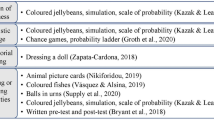Abstract
In this paper, we present the design and the results of a teaching experiment carried out to investigate the hypothesis that it is feasible to facilitate the students’ possibility for experiencing the reactivation of the objectification of the right-angled triangle. For this purpose, a teaching design of the Pythagorean Theorem was developed and taught to an experimental class of 14-year old students. The results of our teaching were compared with a control class with the employment of a questionnaire and semi-structured interviews. The quantitative and qualitative analyses supported our hypothesis that the students of the experimental class would develop qualitatively different understandings of the theorem than the control class, thus suggesting their possibility for experiencing the reactivation of the objectification of the right-angled triangle.








Similar content being viewed by others
References
Ahern, K. J. (1999). Ten tips for reflexive bracketing. Qualitative Health Research, 9(3), 407–411.
Arcavi, A., & Isoda, M. (2007). Learning to listen: From historical sources to classroom practice. Educational Studies in Mathematics, 66, 111–129.
Audi, R. (Ed.). (1999). Cambridge dictionary of philosophy. Cambridge: Cambridge University Press.
Ayer, A. J. (1971). Language, truth and logic. London: Penguin.
Brown, T., & Haywood, D. (2011). Geometry, subjectivity and the seduction of language: The regulation of spatial perception. Educational Studies in Mathematics, 77(2–3), 351–367.
Derrida, J. (1989). In J. P. Leavey (Ed.), Edmund Husserl’s origin of geometry: An introduction. Lincoln: Bison/University of Nebraska Press.
Duval, R. (2006). A cognitive analysis of problems of comprehension in a learning of mathematics. Educational Studies in Mathematics, 61, 103–131.
Freudenthal, H. (1983). Didactical phenomenology of mathematical structures. Dordrecht: Kluwer.
Fried, M. (2001). Can mathematics education and history of mathematics coexist? Science Education, 10, 391–408.
Gravemeijer, K. (1994). Developing realistic mathematics education. Utrecht: CD-b Press.
Harel, G., & Tall, D. (1991). The general, the abstract, and the generic in advanced mathematics. For the Learning of Mathematics, 11(1), 38–42.
Heath, T. L. (1956). The thirteen books of Euclid’s elements. New York: Dover.
Husserl, E. (1974). Kant and the idea of transcendental philosophy. The Southwestern Journal of Philosophy, 5(3), 9–56.
Husserl, E. (2001). In J. N. Findlay (Ed.), Logical investigations. London: Routledge.
Jankvist, U. T. (2009). A categorization of the “whys” and “hows” of using history in mathematics education. Educational Studies in Mathematics, 71(3), 235–261.
Langdridge, D. (2008). Phenomenology and critical social psychology: Directions and debates in theory and research. Social and Personality Psychology Compass, 2(3), 1126–1142.
Lappas, D., & Spyrou, P. (2006). A reading of Euclid’s elements as embodied mathematics and its educational implications. The Mediterranean Journal for Research in Mathematics Education, 5(1), 1–16.
Maor, E. (2007). The Pythagorean theorem: A 4000 year history. Princeton: Princeton University Press.
Merfeld, D. M., Zupan, L., & Peterka, R. J. (1999). Humans use internal models to estimate gravity and linear acceleration. Nature, 398, 615–618.
Mitchelmore, M. C., & White, P. (2000). Development of angle concepts by progressive abstraction and generalisation. Educational Studies in Mathematics, 41, 209–238.
Morgan, C. (2006). What does social semiotics have to offer mathematics education research? Educational Studies in Mathematics, 61, 219–245.
Nagel, T. (1989). View from nowhere. New York: Oxford University Press.
Noback, C. R., Strominger, N. L., Demarest, R. J., & Ruggiero, D. A. (2005). The human nervous system. Totowa: Humana Press.
Lakoff, G., & Núñez, R. (2000). Where mathematics comes from. New York: Basic Books.
Radford, L. (1997). On psychology, historical epistemology, and the teaching of mathematics: Towards a socio-cultural history of mathematics. For the Learning of Mathematics, 17(1), 26–33.
Radford, L. (2003). Gestures, speech and the sprouting of signs: A semiotic-cultural approach to students’ types of generalization. Mathematical Thinking and Learning, 5(1), 37–70.
Radford, L. (2006). The anthropology of meaning. Educational Studies in Mathematics, 61(1), 39–65.
Radford, L. (2013). Three key concepts of the theory of objectification: Knowledge, knowing, and learning. Journal for Research in Mathematics Education, 2(1), 7–44.
Ricoeur, P. (1986). In C. Kelbley (Ed.), Fallible man. New York: Fordham.
Sokolowski, R. (2000). Introduction to phenomenology. New York: Cambridge University Press.
Spyrou, P., Moutsios-Rentzos, A., & Triantafyllou, D. (2009). Teaching for the objectification of the Pythagorean theorem. In L. Paditz & A. Rogerson (Eds.), Proceedings of the 10th International Conference of the MEC21 Project (pp. 530–534). Dresden: MEC21.
Spyrou, P. & Moutsios-Rentzos, A. (2011). Η εξαντικειμενίκευση του ορθογωνίου τριγώνου σε μια διδασκαλία του Πυθαγορείου Θεωρήματος [The objectification of the right-angled triangle in a teaching of the Pythagorean theorem]. In Μ. Kaldrimidou & X. Vamvakousi (Eds.), Proceedings of the 4th Conference of the Greek Association for Research in Mathematics Education (pp. 459–468). Ioannina, Greece: Εν.Ε.Δι.Μ.- University of Ioannina.
Author information
Authors and Affiliations
Corresponding author
Rights and permissions
About this article
Cite this article
Moutsios-Rentzos, A., Spyrou, P. & Peteinara, A. The objectification of the right-angled triangle in the teaching of the Pythagorean Theorem: an empirical investigation. Educ Stud Math 85, 29–51 (2014). https://doi.org/10.1007/s10649-013-9498-y
Published:
Issue Date:
DOI: https://doi.org/10.1007/s10649-013-9498-y




